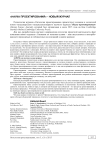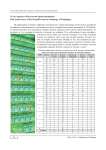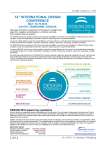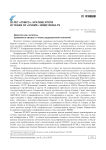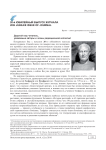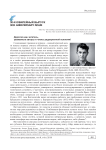Статьи журнала - Онтология проектирования
Все статьи: 495
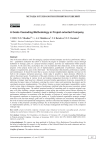
A goals cascading methodology in project-oriented company
Статья научная
One of the most effective tools for managing a project-oriented company are the key performance indicators - quantitative indicators that allow to measure the degree of company's activities success through definition of strategic goals. In a project-oriented company, activities are implemented within projects execution. At the same time, each project has a set of parameters that characterize, on the one hand, the progress of the project (terms and cost of implementation, qualification of performers, frequency of changes in requirements), and, on the other hand - the final product (functionality, performance, usability and maintenance). It should be noted that a success of project implementation depends not least on the built in the company interaction processes, which make it possible to make decisions effectively to achieve the project goals. Visualization of the goals relations on the strategic map significantly facilitates the employees interacting at various levels and making management decisions in problem situations. Building a strategic map based on a balanced scorecard implies appointment of persons, responsible for achieving the target values of indicators, entering the correct values and monitoring the projects and its constituent processes implementation. This allows forming a project participants responsibility matrix, which, in turn, helps to determine a degree of performers workload when the processes execution, related to various knowledge areas. The authors' proposed method of cascading goals in a project-oriented company will allow building a project management system taking into account various factors affecting the success of its implementation. Cascading is based on building a hierarchy of a project-oriented company performance indicators in accordance with the hierarchy of projects of various types and scales. Using this approach contributes to improving the quality of a project-oriented organization strategic management due to the fact that strategic goals and its corresponding indicators are consistently decomposed to the level of tactical and operational management, and then concretized and adapted in structural divisions. A novelty of the proposed cascading technique lies in development of the projects hierarchy in terms of its implementation priority, as well as in use of project management knowledge areas in the company's strategic map.
Бесплатно
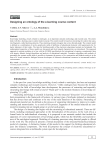
Designing an ontology of the e-learning course content
Статья научная
Knowledge modeling, closely related to ontologies, is an important semantic technology and research area. The article deals with the e-learning course content model concept. The content model is based on structuring the content into separate fragments, called learning elements. These learning elements integrate into a tree directed graph. The content model is defined as a combination of such a graph and a table of attributes of educational elements with requirements for didactic indicators of their study. The rules for building models of the electronic educational content are formulated. The mathematical properties of these models are discussed and their integral characteristics are introduced. The proposed approach to content modeling is in line with the SCORM specifications for international e-learning, complements them with targets, didactic design algorithms and analysis of educational materials. Formation algorithms and methods of presenting the content model make it possible to automate the process of its construction and didactic analysis in the form of a visual interactive dialogue between developers of electronic educational resources in instrumental author's environments.
Бесплатно
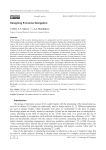
Статья научная
In the design of the e-course learning process, it is proposed to use the concept of a navigation model. This model provides convenient and didactically based navigation through the educational material of the course. The work is based on the recent research of the authors on the structuring of educational content in the form of an e-course content model, ordered in the form of a hierarchical structure of the ontologies of learning elements that make up the course. The navigation model concept includes a set of matrices of relations of order and logical coherence of learning elements and corresponding to these matrices of orgraphs of the sequence of study and logical coherence of fragments of educational content. The navigation model answers two important questions of designing an electronic course: 1) what should be the didactically rational sequence of studying the learning elements in the course that is being created; 2) what logical connections should be established between the individual learning elements of the course in order to ensure convenient and didactically based navigation of the course. The mathematical substantiation of the navigation model is given, its properties are investigated, and integral characteristics are introduced. The use of the e-course navigation model helps to: determine and visually represent a rational sequence of studying the educational material, as well as the logical reference links between its various fragments; provide effective assistance to students in navigating the course; analyze and compare different educational materials, assess the level of didactic significance of various learning elements; minimize the complexity of preparing exercises for training and control tests, and the complexity of training and control procedures for e-learning. The concept of a navigation model complies with the international e-learning standards SCORM and IMS, complements them with specific algorithms for aggregating learning objects (SCOs) into e-courses, and assists students in learning them. The mathematical substantiation of the navigation model makes it possible to automate the design of e-courses.
Бесплатно
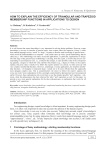
Статья научная
It is well known that expert knowledge is very important for solving design problems. However, expert knowledge is not easy to describe in precise terms, since experts often use imprecise (“fuzzy”) words from natural language such as “small” or “large”. In order to describe such knowledge in precise terms - which would be understandable to a computer - Lotfi Zadeh came up with a special methodology that he called fuzzy. This methodology had many successful applications, in particular, applications to design. The first stage of the general fuzzy methodology is eliciting, from the expert, a membership function corresponding to each imprecise term, i.e., a function that assigns, to each possible value of the corresponding quantity, a degree to which this value satisfies this property (e.g., a degree to which, in the expert's opinion, this given value is small). If we follow the expert's opinion very closely, we often come up with very complex membership functions. However, surprisingly, in many applications, the simplest membership functions - of triangular or trapezoid shape - turned out to be more efficient than the supposedly more adequate complex ones. This is counterintuitive: the closer we follow the expert’s opinion, the worse our result. Some explanations for this seemingly counterintuitive phenomenon have been proposed earlier. However, these explanations only work when we use the simplest possible “and”-operation - minimum, while this phenomenon has been observed for other “and”-operations as well. In this paper, we provide a new, more general explanation for the above phenomenon, an explanation that works for all possible “and”-operations.
Бесплатно
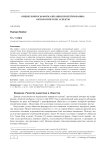
Статья научная
Мы живём в эпоху 4-й промышленной революции, и возникает закономерный вопрос - а что дальше? Кому будет принадлежать ведущая роль в новом цифровом мире - искусственному интеллекту или человеку? Для поиска ответов необходимо совершить небольшой экскурс в историю. Развитие технологий всегда меняло уклад жизни общества: усмирив энергию воды и пара, человечество сделало шаг из общества охотников в аграрное общество. Появление электрической энергии и конвейера позволили нам трансформироваться в индустриальное общество. Электронные информационные технологии привели нас на современный этап развития - к информационному обществу. Каков следующий шаг? Если Индустрия 4.0 посвящена автоматизации физико-технических процессов, то новый уклад Общество 5.0 в первую очередь ориентирован на автоматизацию процессов коммуникации и сотрудничества людей и интеллектуальных систем. Искусственный интеллект, повсеместное внедрение «цифры» должны помочь в достижении главного результата - увеличения продолжительности жизни, повышения её качества и появления людей-«акторов», создающих объекты интеллектуальной собственности, которые затем материализуются киберфизическими системами.
Бесплатно
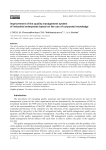
Статья научная
This article analyzes the procedures for improving quality management using the example of solving problems of compliance with product quality requirements at industrial enterprises. The quality of the products largely depends on the use of modern methods and tools of quality management, as well as on improving the competence of personnel in the field of quality systems. In this regard, it is proposed to apply the corporate knowledge of the enterprise, including models and algorithms of artificial intelligence. Corporate knowledge is formed on the basis of the formation and processing of documentation, interviewing qualified specialists and intellectual data analysis on the implementation of business processes. During the research, an ontology of quality management was developed, decision-making rules were created and the results of improving the quality management system using a neuro-fuzzy network were predicted. The use of these artificial intelligence tools will make it possible to form a unified terminology to ensure an unambiguous perception of information by all participants in the process and the use of a knowledge base to support decision-making. It is proposed to use quality management tools to improve the efficiency of decisions made by intelligent tools, i.e. production rules and neural networks.
Бесплатно
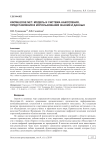
Knowledge net: модель и система накопления, представления и использования знаний и данных
Статья научная
Описана разрабатываемая авторами модель Knowledge Net, предназначенная для формализации накопления, представления и использования знаний и данных единого информационного пространства интеллектуального предприятия, в том числе в рамках концепции Индустрия 4.0. В основу модели Knowledge Net положена графовая модель данных. Модель Knowledge Net является частью прикладных разработок цифровой платформы предприятия. Разработка программной системы, поддерживающей модель Knowledge Net, выполняется в концепции открытого программного кода. В работе приведён пример использования программного прототипа для описания объектов производственного предприятия. Ключевой особенностью Knowledge Net, отличающей разработку от известных аналогов, является комбинация таких свойств, как поддержка многоаспектности описания субъектов и объектов предприятия, возможность расширения сети понятий и сущностей вместе с развитием предприятия, динамическое формирование структуры аспектов и их свойств, множественность возможных типизаций сущностей, представленных моделью Knowledge Net, а также поддержка версионности модели знаний и данных.
Бесплатно
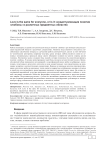
Статья научная
Работа посвящена созданию онтологической модели понятия «любовь» при помощи концептуализации предметной области в различных дисциплинах. Развитие искусственного интеллекта способствовало увеличению интереса к улучшению работы автоматических систем за счёт обучения их человеческим категориям, например чувствам, среди которых любовь является одним из основных эмоциональных процессов ввиду своего обширного влияния на многие стороны жизни человека. Поставлена задача создания базы знаний, которая позволила бы концептуализировать понятие «любовь». В основу проектирования такой базы положен онтологический подход. Проведён краткий обзор имеющихся исследований и классификаций видов любви в выбранных дисциплинах, полученные в результате онтологии в виде концептуальных схем представлены на валидацию экспертам в соответствующих дисциплинах. Важным и значимым аспектом при проектировании онтологии любви на начальных этапах является корректное отображение основных её видов и атрибутов для дальнейшего проектирования связанных отношений между ними. На основе исследований европейской культуры предложен онтологический анализ понятия «любовь» с позиций следующих дисциплин: биологии, философии, психологии, социологии и искусства различных жанров. Полученные результаты, с учётом их дальнейшего развития, могут быть использованы при создании приложений искусственного интеллекта, моделирующих чувственную и эмоциональную сферу человеческой деятельности, в частности, любовь. Ключевые слова: любовь,
Бесплатно
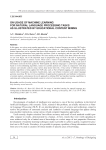
Статья научная
In this paper, we review most popular approaches to a variety of natural language processing (NLP) tasks, primarily those, which involve machine learning: from classics to state-of-the-art technologies. Most modern approaches can be separated into three rough categories: ones based on distributional hypothesis, those extracting information from graph-like structures (such as ontologies) and the ones that look for lexico-syntactic patterns in text documents. We focus mainly on the former of the three. Before the analysis can even begin, one of the important steps in preparation stage of NLP is the task of representing words and documents as numeric vectors. There exists a variety of approaches from the most simplistic Bag-of-Words to sophisticated machine learning methods, such as word embedding. Today, in the task of information retrieval the best quality for both English and Russian languages is achieved by approaches based on word embedding algorithms, trained on carefully picked text corpora in conjunction with deep syntactic and semantic analysis using various deep neural networks. A big variety of different machine learning algorithms is being applied for NLP tasks such as Part-of-Speech-tagging, text summarization, named entity recognition, document classification, topic and relation extraction and natural language question answering. We also review possibilities of applying these approaches and methods to educational content analysis, and propose the novel approach to utilizing NLP and machine learning capabilities in analyzing and synthesizing educational content in a form of a decision support systems.
Бесплатно
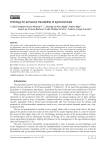
Ontology for pervasive traceability of agrochemicals
Статья научная
The growth of the world population forces a more outstanding and more efficient food production, forcing agribusiness into the race for greater productivity. Thus, agrochemicals as a tool for increasing and defending production have become more critical with each harvest. This work presents an ontology that describes the knowledge involved in the need for Agrochemical Pervasive Traceability Model (APTM). This proposed ontology is called ontology for pervasive traceability of agrochemicals (OntoPTA). We present classes and their relationships in a hierarchical way and a visualization from the OWL ontology language. This ontology fills the gap in the understanding and modeling of this type of agribusiness process. This modeling helps farm administrators and software developers to perform better analysis for the development, use and maintenance of systems in agribusiness.
Бесплатно
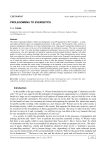
Статья научная
The article expounds prefatory remarks and explanatory essay (Prolegomena) to the Evergetics - a value-and subject-oriented science on management processes in the society. The Evergetics seeks reserves to improve management efficiency not in the modernization of an “impersonal” bureaucratic machine, but in the people, in every man, in the use of his intellectual and volitional resources. The man is considered there not as a “cog” of a value-invariant management mechanism, but as a person (actor), endowed with consciousness, who acts rationally and performs cognitive-activity-related functions together with other people to resolve any problem situations that arise in everyday life. These heterogeneous actors having their own subjective views of the world and value priorities, based on the Poincaré's conventional concept of truth, which treats the truth as a result of an agreement, produce intersubjective knowledge, on the basis of which they make a collective decision on how to settle the situation. Perception of meaning of the situation by each heterogeneous actor happens at the level of individual consciousness. However, one person cannot constitute the whole variety of meanings of the situation, so this person receives from others what lacks in his own experience. Meaning-generating activity of people has an impact on all intersubjective community and, as a result, a common meaning-bearing space appears. A holonic approach is used in the Evergetics (on a “part-whole” principle) to build systems in contrast to the traditional causal approach (on a “cause-effect” principle). The article emphasizes strategic significance of the problem to transform the “Economic Man” to the “Man of Culture”.
Бесплатно
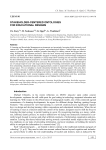
Stakeholder-centered ontologies for educational designs
Статья научная
E-Learning and Knowledge Management environments are increasingly becoming highly interactive and content-rich. They encapsulate social, cognitive, and technological aspects. Concept maps are effective means to generate and organize multiple grounded knowledge for sharing content and trigger behavior along learning and development processes. Since the basic concept map structure and procedure can easily be explained, the various stakeholders engaged in learning processes and knowledge management activities can benefit from these capabilities. Concept maps allow encoding not only relevant information but also elaborating different perspectives on information elements. In this way, meaningful content and features for interaction can effectively be conveyed. We demonstrate the non-intrusive and non-disruptive use of concept maps for user- and usage-centered design of learning environments. The approach spans from articulating educational designs and tagging didactic content to purposeful navigation and traceable design spaces. We use metadata to encode educational intention for learning support. They also allow using content elements in different educational contexts. Their handling can be aligned with existing features of learning support systems including social media. By understanding such application development as a learning process itself, concept mapping enforces systemic understanding and thus, accelerates further developments in context-sensitive design, as our findings from the field reveal.
Бесплатно
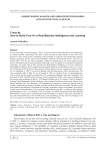
Trans-AI: how to build true ai or real machine intelligence and learning
Статья научная
We are at the edge of colossal changes. This is a critical moment of historical choice and opportunity. It could be the best 5 years ahead of us that we have ever had in human history or one of the worst, because we have all the power, technology and knowledge to create the most fundamental general-purpose technology (GPT), which could completely upend the whole human history. The most important GPTs were fire, the wheel, language, writing, the printing press, the steam engine, electric power, information and telecommunications technology, all to be topped by real artificial intelligence technology. Our study refers to Why and How the Real Machine Intelligence or True AI or Real Superintelligence (RSI) could be designed and developed, deployed and distributed in the next 5 years. The whole idea of RSI took about three decades in three phases. The first conceptual model of Trans-AI was published in 1989. It covered all possible physical phenomena, effects and processes. The more extended model of Real AI was developed in 1999. A complete theory of superintelligence, with its reality model, global knowledge base, NL programing language, and master algorithm, was presented in 2008. The RSI project has been finally completed in 2020, with some key findings and discoveries being published on the EU AI Alliance/Futurium site in 20+ articles. The RSI features a unifying World Metamodel (Global Ontology), with a General Intelligence Framework (Master Algorithm), Standard Data Type Hierarchy, NL Programming Language, to effectively interact with the world by intelligent processing of its data, from the web data to the real-world data. The basic results with technical specifications, classifications, formulas, algorithms, designs and patterns, were kept as a trade secret and documented as the Corporate Confidential Report: How to Engineer Man-Machine Superintelligence 2025. As a member of EU AI Alliance, the author has proposed the Man-Machine RSI Platform as a key part of Transnational EU-Russia Project. To shape a smart and sustainable future, the world should invest into the RSI Science and Technology, for the Trans-AI paradigm is the way to an inclusive, instrumented, interconnected and intelligent world.
Бесплатно
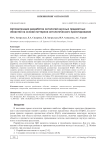
Статья научная
В настоящее время онтологии признаны наиболее эффективным средством формализации и систематизации знаний и данных в научных предметных областях (НПрО). Однако разработка онтологии является сложным и трудоёмким процессом. Практика показала, что при разработке онтологий НПрО, особенно эффективно применение паттернов онтологического проектирования. Это связано с тем, что в онтологии НПрО, как правило, содержится большое количество типовых фрагментов, которые хорошо описываются паттернами онтологического проектирования. Благодаря тому, что использование паттернов онтологического проектирования значительно облегчает разработку онтологии НПрО, к ней можно привлечь экспертов в моделируемой НПрО, не владеющих навыками онтологического моделирования. Для получения онтологии НПрО, необходимо обработать огромное количество публикаций, релевантных моделируемой НПрО. Облегчить и ускорить процесс пополнения онтологии информацией из таких источников можно за счёт использования лексико-синтаксических паттернов онтологического проектирования. В статье представлен подход к автоматизированному построению онтологий НПрО на основе системы разнородных паттернов ОП. Система включает паттерны ОП, предназначенные для разработчиков онтологий, и автоматически построенные на их основе лексико-синтаксические паттерны, с помощью которых может выполняться автоматическое пополнение онтологии информацией, извлекаемой из текстов на естественном языке.
Бесплатно

